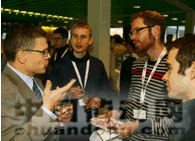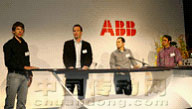2007年11月2日消息, ABB于10月底在瑞士Dättwil為慶祝全球企業(yè)投資研究中心成立40年周年舉行的紀(jì)念會(huì)上,舉辦了創(chuàng)新論壇活動(dòng),論壇上進(jìn)行了自然科學(xué)的演講,學(xué)生們參加了ABB技術(shù)的未來(lái)是人類(lèi)的討論。
在論壇的一開(kāi)始,ABB瑞士經(jīng)理Jasmin Staiblin便問(wèn):“未來(lái)將會(huì)帶來(lái)什么?”此問(wèn)題一經(jīng)提出,讓與會(huì)的人員都感到疑惑。她接著又說(shuō):“人才、趨勢(shì)、技術(shù),這三個(gè)點(diǎn)是ABB未來(lái)成功的基本元素。”此外,大范圍關(guān)于人類(lèi)生活中技術(shù)角色的討論,使參與者獲得了許多直接洞察ABB的機(jī)會(huì)。
[IMG=ABB瑞士公司總經(jīng)理Jasmin Staiblin]/uploadpic/news/2007/11/2007110608374225106M.jpg[/IMG]
ABB瑞士公司總經(jīng)理Jasmin Staiblin
專(zhuān)注于技術(shù)
ABB在Dättwil的研究中心成立于1967年,其核心研究領(lǐng)域?yàn)樽詣?dòng)化、高壓技術(shù)、物料科學(xué)和電力電子。Staiblin曾說(shuō)過(guò),ABB的創(chuàng)新首先應(yīng)包括發(fā)現(xiàn)具有應(yīng)對(duì)挑戰(zhàn)和創(chuàng)造性的人才,專(zhuān)業(yè)技術(shù)人員的流動(dòng)短缺對(duì)于企業(yè)是種損失。
她又說(shuō):“在這其中,優(yōu)秀的教育系統(tǒng)是絕對(duì)有必要的,在未來(lái),科學(xué)仍將在各學(xué)科之間起重要的作用。我們需要喚起我們對(duì)技術(shù)的熱情,比如在我們的日間托兒所中有規(guī)律地組織的技術(shù)學(xué)習(xí)。”
能源使用效率
創(chuàng)新也意味著參與未來(lái)的需要。能源使用效率是涉及ABB成為公眾依賴的技術(shù)公司的重要方面。Staiblin說(shuō):“氣候變化、能源和水源源短缺是全球化問(wèn)題。在一些地方,人們已經(jīng)開(kāi)始認(rèn)識(shí)到了問(wèn)題的嚴(yán)重。幸運(yùn)的是:技術(shù)不僅是產(chǎn)生問(wèn)題,還同樣是問(wèn)題的解決方法。我們需要加強(qiáng)我們的意識(shí)認(rèn)知。”
11億美元投資于研發(fā)
ABB集團(tuán)首席技術(shù)官Peter Terwiesch為ABB成功地從試驗(yàn)室到市場(chǎng)開(kāi)發(fā)的技術(shù)做了總述。如:高壓直流輸電技術(shù)、變速驅(qū)動(dòng)型輕型高壓直流輸電和用于芯片、光纖傳感器和無(wú)線接近開(kāi)關(guān)的Azipod推動(dòng)系統(tǒng)。
[IMG=ABB集團(tuán)首席技術(shù)官Peter Terwiesch]/uploadpic/news/2007/11/2007110608393833315E.jpg[/IMG]
ABB集團(tuán)首席技術(shù)官Peter Terwiesch
Terwiesch說(shuō):“ABB每年將11億美元用于研發(fā)當(dāng)中,加強(qiáng)ABB業(yè)務(wù)與技術(shù)之間的強(qiáng)互作用。公司的業(yè)務(wù)戰(zhàn)略對(duì)我們的研發(fā)中心具有很大的影響。相反地,研發(fā)中心的每一項(xiàng)研究也會(huì)影響管理層的決定。”
來(lái)自實(shí)驗(yàn)室的virtual trip
Dättwil研究中心的領(lǐng)導(dǎo)Otto Preiss利用圍繞實(shí)驗(yàn)室的virtual trip闡述了研究是如何執(zhí)行的,描述了從想法到產(chǎn)品的過(guò)程。他還強(qiáng)調(diào)了ABB與一些大學(xué)之間的合作:目前,我們雇用了60個(gè)實(shí)習(xí)人員和大學(xué)生,與20所大學(xué)簽有合作協(xié)議,其中三分之二來(lái)自瑞士。
與ABB合作的好處
在ABB與瑞士大學(xué)的合作中,已有80名學(xué)生接受了ABB的領(lǐng)導(dǎo)Daniel Huber的面試,其中有三名年輕的雇員已經(jīng)開(kāi)始在ABB工作了。一位大學(xué)生說(shuō):“能聽(tīng)聽(tīng)他們?nèi)挥懻撍麄兠刻斓墓ぷ鹘?jīng)驗(yàn)是一件非常有意義的事。”在隨后的接待中,學(xué)生們還有與ABB研究人員面對(duì)面討論的機(jī)會(huì)。
[FONT=times]
original text [/FONT]
[font=times] The future of technology is people [/font]
[font=times][Color=#708090]2007-11-02 - An innovation forum at the end of October marking the 40th anniversary of the Corporate Research Center in Dättwil, Switzerland, introduced science lecturers and students to the future of ABB technology - people.
"What will the future bring?" asked ABB Switzerland country manager, Jasmin Staiblin at the beginning of the forum, which was dubbed "Talent, Trends and Technology." Each of the three "Ts" is an essential element in ABB‘s future success. In addition to wide-ranging discussions about the role of technology in our lives, participants gained many insights into ABB‘s research activities.
Awaking enthusiasm for technology
ABB‘s research center in Dättwil was opened in 1967, and its core research areas are automation and high-voltage technology, material sciences and power electronics. Staiblin said innovation for ABB involves first and foremost finding, challenging and encouraging creative talent – no easy task given the current lack of specialist workers.
"An excellent educational system is absolutely essential in this, with science continuing to play an important part in the interdisciplinary landscape in the future," she said. "We need to awaken enthusiasm for technology ourselves, for example by organizing technology days regularly in our day nurseries."
Energy efficiency
Innovation also means anticipating future needs. Energy efficiency, for example, was a concern in ABB long before it became an issue for the wider public. "Climate change and shortages of energy and water are major global problems. In some places, people have started to realize, luckily, that technology not only creates problems but can also be the means of solving them," Staiblin said. "We need to strengthen this realization.
$1.1 billion invested in R&D
Peter Terwiesch, Chief Technology Officer at the ABB Group, gave an overview of pioneering ABB technologies that have successfully moved from lab to marketplace: for example, high-voltage direct current power transmission technologies HVDC and HVDC light, variable speed drives, Azipod propulsion systems for ships, fiber-optic sensors and wireless proximity switches.
"ABB spends $1.1 billion every year on research and development," Terwiesch said, adding there is a strong interaction between the business and ABB technology. "The company‘s business strategy has a massive influence on the work in our research centers. Conversely, everything that goes on in the research centers also affects management decisions."
A virtual trip through the laboratories
Dättwil‘s head of research, Otto Preiss, used a virtual trip around the laboratory to explain how research is carried, and described the stages required to turn an idea into a product.
He also underscored how important collaboration with universities is for ABB: "We currently employ over 60 interns and undergraduates, and have 30 cooperation agreements with 20 universities, around two-thirds of which are Swiss."
Incentives to cooperate with ABB
Particularly interesting to the 80 students attending was an interview between Daniel Huber, head of ABB Switzerland University Marketing, and three young employees who had recently started work with ABB. "It was really fascinating to hear these three talking about their day-to-day work experiences," said one university graduate – adding that he too would probably apply for work at ABB.
At a later reception, students had a chance to talk to ABB researchers, and learn about open positions.
IMAGE1:ABB Switzerland country manager, Jasmin Staiblin.
IMAGE2:Peter Terwiesch, Chief Technology Officer at the ABB Group.
IMAGE3:Dättwil‘s head of research, Otto Preiss (left), with students.
IMAGE4:"It was really fascinating to hear these three talking about their day-to-day work experiences"[/color][/font]
聲明:本文為中國(guó)傳動(dòng)網(wǎng)獨(dú)家稿件。未經(jīng)許可,請(qǐng)勿轉(zhuǎn)載。
下一篇:
?
物流行業(yè)的PLC應(yīng)用值得關(guān)注?
IMS最新的一份研究報(bào)告預(yù)計(jì)到2011年,中國(guó)整體PLC市場(chǎng)中,面向機(jī)器制造商部分的總銷(xiāo)售額將達(dá)到10.26億美元

















![]()
![]()
![]()
![]()